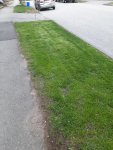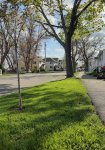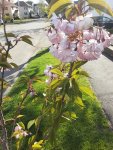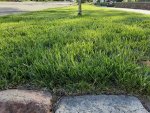Hello, I'm Steve from Boston. I could really, really use some input on my lawn. I have been working at the strip of grass in front of my house beside the street for several years now, and have done all I can think of to improve it. In 2015, It was originally maybe 5% grass and the rest burnt out or weeds, just horrible. So, I totally overhauled it, scraped the excess soil + leveled it off to counteract the buildup of organic matter that had increased the height far higher than the curb over 100+ years, With it now physically formed properly, I cut it a giant tree root protruding in one area to finalize that part of it. I then brought in a nice compost mix, and spread it all throughout, raking it in thoroughly. Over the next month I worked to add, high quality mostly kentucky blue grass seed, with some fescue incase the bluegrass got knocked back by our summer heat. There is a big norway maple on one side that provides some shade, which is a nice relief for it from direct uv rays. I also added lime(or hardwood ash depending on the year), and Milorganite. I used no chemical fertilizer. The seed all came up great, and looked beautiful.
I thought, great, the soil remediation worked, limed counteracted whatever salt the trucks sprayed during winter+any soil natural acidity, and Milorganite helped with soil enrichment/fertilizer, I'm all set. But... only a week or so later, let's call it late spring/early summer, The lawn, in seemingly random areas, began to go yellow/brown. It became almost, more dry/coarse, changed from that lively soft green grass to something seemingly being drained of it's essence. My reaction that year, 2015, was "it needs water", so I watered it every day. It did not help. I'd say 50% of the front lawn died out this way, and I had to reseed in fall to bring it back; it was very, very disappointing.
2016: The grass came in beautifully in the spring, and.I repeated the same process; Milorganite+pelletized Lime, and once again, it looked beautiful - golf course lawn; thick, lush, deep green. Also once again, the same curse of late spring hit again. Random yellowing, then browning/thinning, then death. I was baffled/disappointed/frustrated. Were there grubs chewing away at it? I dug in random areas, found almost nothing, maybe 1-2 grubs, threw them to the birds. Is there a gas line leak somewhere? The pipes are pretty new, so unlikely, but how can I be sure? All these 'what if' thoughts running through my head. So I did all I could do; let it die off halfway again during summer, reseeded in fall.
2017: Came in great again early/mid spring, but this year I instead of watering consistently, I watered with longer breaks in between, but more deeply, thinking maybe the constant water was causing a fungus or something that was causing this. No difference, same exact problems.
2018: When warmer daytime temps hit along with spring rains, it once again came in great, so I repeated same watering pattern; deeply/thoroughly. This year, though, I used a high quality expensive chemical fertilizer made mainly for lawns, but used it sparingly so as no to burn the lawn, instead of using Milorganite, thinking maybe the soil was just lacking in NPK or some other nutrient. This doesn't seem to make sense logically, since it grows so perfectly in early spring, but I was at a loss at this point. The resuls were exactly the same; lawn did great 'til late spring/early summer, then the seemingly sporadic 50% yellow/brown/burnout. I really don't feel the chem fert "burn" the lawn in traditional means, it died out the same as the other years. I had lost more grass this summer than previous years, so I decided to change my seed entirely to a different brand, type, everything. There was still some bluegrass, but it was more a fescue(TTTF) dominant mix with some perennial ryegrass. This was, like the others, a high quality seed. As with the emerging spring grass, the newly seeded grass in the fall came up beautifully. Early spring and fall seem never to be a problem - the problem starts late spring and ends in fall when temps begin to cool a bit.
2019: Almost an exact repeat this year.
--Now, Present Year/Month--
2020: Another almost exact repeat. I tried to give it "just enough" water. We had great spring rains, it pushed up and filled in so thickly, it looks as if not even crabgrass could get started. Just perfect looking. But now, the same thing is beginning to happen AGAIN. Not everywhere, maybe 20-30% of it so far. It begins with the lawnmower cutting it, and for the first time after maybe 6-8 mows, the tips of the grass are clearly brown, making the grass look brownish. No idea why the lawn mower(Honda twin blade, no bag recycling), is turning tips brown, since it does not do this for the first few early-mid spring cuts. .Then, certain areas began to yellow, become thin, blades lose their tithe, and are seemingly waning away again to brown dead nothing. Right now as I post this(5-30-2020) none of it is dead/brown YET, but it looks like it's par for course again.
I've thought of as many possible things as I could. Even such things as..could the mower be randomly leaking oil/gas over some areas without me knowing? But I've seen/smelt nothing of the sort, nor would it make sense since im meticulous with machine maintenance.
What I'm putting on the lawn is so mild, I just can't picture lime/Milorganite having any kind of negative impact on it.
After trying both watering methods; small amount of water every or every other day, and deep water every 4-6 days. Neither made a difference.
I've even pushed my finger into about 30 different areas all over the lawn, and the soil was damp, so there was certainly available moisture. The grass seems very firmly rooted, too, and the soil type is, to me, ideal. Not a heavy clay, not a light sand; right in between.
The only potential 'negative' I noticed is that when I water, it pools in some areas. I don't know if this is because of the amount of organic materials being shot down into the lawn/soil by the twin blade mulching Honda, which I push rather slowly so it minces everything up very fine, and perhaps the soil can't decompose it all quickly enough, or if the soil - in some areas at least - just can't take that much water that quickly for whatever reason, if it needs a surfactant, or physical aeration, or what.
That is literally the only thing I can come up with. I do not understand, for the life of me, what could be causing this problem, and it's immensely frustrating. There are a couple neighbors who have old, old lawns, do near-nothing to them, and though they don't look as nice in early-mid spring, they don't have this problem, so they transition into summer perfectly and end up looking better, very healthy, all summer long, even if they go dormant due to summer heat, they bounce right back late summer/fall. They are species/cultivars of grass that obviously are acclamated and in harmony/have tolerance to my area. But, like I said, I tried many types of seed, and none seem to work. I've worked on many people's lawns over the years(not professional, but more as an educated amateur), and I've never once seen a problem like this which I can't logically reason through. Some might be thinking "soil test", which I've never had done, but also gives me pause because the lawn grows beautifully in spring and seeds come up beautifully in fall and re-emerge just as nicely in spring, so a nutrients detriment? I just don't know, don't think so, but obviously I can't know for sure. I cut it rather short but not short short, maybe 1.5-2". I one year tried cutting it closet to 2.5", but it seemed not to want to grow that high, and began to flop over when it got close to 2.5". If I recall, the same issues with yellow/browning happened regardless.
Does anyone have ANY input for this? I am completely out of ideas, and exhausted, over this little strip of front lawn. I can't know what's underneath the ground re: pipes, don't realy want to call digsafe or the town and get them to check for leaks, and truly don't think it's something like a leaky gas line. They can usually detect those anyway, and I've had that before @ old house and you could easily smell it; no such smell here. Also, I don't have a sprinkler system, but I water religiously, out there at 5-6 am watering it deeply before heat can evaporate it. In the real real hot days of mid/late summer I'll spritz it mid-day when its scorching, like golf courses do - just for a couple minutes - so the water can wick away the damaging super heat. I mean I've tried everything to keep this grass alive. I might be forgetting something, since this has been a 5 year struggle and there's so much to it, but that's as best as I can sum it up.
ANY advice/input/questions would be highly appreciated; thank you very much.
Here is an example of how it looked early spring after it came in. To me, this looks healthy, starting to bounce back from winter and thicken up.:

It then gets to it's "best" look, around mid-spring, right before late spring, meaning, right before it begins to fade to yellow in certain areas:



I will go out and take pics of the yellowing/thinning tomorrow to give you an idea, but you can imagine it I'm sure.
Once again, any replies of any kind are greatly appreciated, thank you again.
I thought, great, the soil remediation worked, limed counteracted whatever salt the trucks sprayed during winter+any soil natural acidity, and Milorganite helped with soil enrichment/fertilizer, I'm all set. But... only a week or so later, let's call it late spring/early summer, The lawn, in seemingly random areas, began to go yellow/brown. It became almost, more dry/coarse, changed from that lively soft green grass to something seemingly being drained of it's essence. My reaction that year, 2015, was "it needs water", so I watered it every day. It did not help. I'd say 50% of the front lawn died out this way, and I had to reseed in fall to bring it back; it was very, very disappointing.
2016: The grass came in beautifully in the spring, and.I repeated the same process; Milorganite+pelletized Lime, and once again, it looked beautiful - golf course lawn; thick, lush, deep green. Also once again, the same curse of late spring hit again. Random yellowing, then browning/thinning, then death. I was baffled/disappointed/frustrated. Were there grubs chewing away at it? I dug in random areas, found almost nothing, maybe 1-2 grubs, threw them to the birds. Is there a gas line leak somewhere? The pipes are pretty new, so unlikely, but how can I be sure? All these 'what if' thoughts running through my head. So I did all I could do; let it die off halfway again during summer, reseeded in fall.
2017: Came in great again early/mid spring, but this year I instead of watering consistently, I watered with longer breaks in between, but more deeply, thinking maybe the constant water was causing a fungus or something that was causing this. No difference, same exact problems.
2018: When warmer daytime temps hit along with spring rains, it once again came in great, so I repeated same watering pattern; deeply/thoroughly. This year, though, I used a high quality expensive chemical fertilizer made mainly for lawns, but used it sparingly so as no to burn the lawn, instead of using Milorganite, thinking maybe the soil was just lacking in NPK or some other nutrient. This doesn't seem to make sense logically, since it grows so perfectly in early spring, but I was at a loss at this point. The resuls were exactly the same; lawn did great 'til late spring/early summer, then the seemingly sporadic 50% yellow/brown/burnout. I really don't feel the chem fert "burn" the lawn in traditional means, it died out the same as the other years. I had lost more grass this summer than previous years, so I decided to change my seed entirely to a different brand, type, everything. There was still some bluegrass, but it was more a fescue(TTTF) dominant mix with some perennial ryegrass. This was, like the others, a high quality seed. As with the emerging spring grass, the newly seeded grass in the fall came up beautifully. Early spring and fall seem never to be a problem - the problem starts late spring and ends in fall when temps begin to cool a bit.
2019: Almost an exact repeat this year.
--Now, Present Year/Month--
2020: Another almost exact repeat. I tried to give it "just enough" water. We had great spring rains, it pushed up and filled in so thickly, it looks as if not even crabgrass could get started. Just perfect looking. But now, the same thing is beginning to happen AGAIN. Not everywhere, maybe 20-30% of it so far. It begins with the lawnmower cutting it, and for the first time after maybe 6-8 mows, the tips of the grass are clearly brown, making the grass look brownish. No idea why the lawn mower(Honda twin blade, no bag recycling), is turning tips brown, since it does not do this for the first few early-mid spring cuts. .Then, certain areas began to yellow, become thin, blades lose their tithe, and are seemingly waning away again to brown dead nothing. Right now as I post this(5-30-2020) none of it is dead/brown YET, but it looks like it's par for course again.
I've thought of as many possible things as I could. Even such things as..could the mower be randomly leaking oil/gas over some areas without me knowing? But I've seen/smelt nothing of the sort, nor would it make sense since im meticulous with machine maintenance.
What I'm putting on the lawn is so mild, I just can't picture lime/Milorganite having any kind of negative impact on it.
After trying both watering methods; small amount of water every or every other day, and deep water every 4-6 days. Neither made a difference.
I've even pushed my finger into about 30 different areas all over the lawn, and the soil was damp, so there was certainly available moisture. The grass seems very firmly rooted, too, and the soil type is, to me, ideal. Not a heavy clay, not a light sand; right in between.
The only potential 'negative' I noticed is that when I water, it pools in some areas. I don't know if this is because of the amount of organic materials being shot down into the lawn/soil by the twin blade mulching Honda, which I push rather slowly so it minces everything up very fine, and perhaps the soil can't decompose it all quickly enough, or if the soil - in some areas at least - just can't take that much water that quickly for whatever reason, if it needs a surfactant, or physical aeration, or what.
That is literally the only thing I can come up with. I do not understand, for the life of me, what could be causing this problem, and it's immensely frustrating. There are a couple neighbors who have old, old lawns, do near-nothing to them, and though they don't look as nice in early-mid spring, they don't have this problem, so they transition into summer perfectly and end up looking better, very healthy, all summer long, even if they go dormant due to summer heat, they bounce right back late summer/fall. They are species/cultivars of grass that obviously are acclamated and in harmony/have tolerance to my area. But, like I said, I tried many types of seed, and none seem to work. I've worked on many people's lawns over the years(not professional, but more as an educated amateur), and I've never once seen a problem like this which I can't logically reason through. Some might be thinking "soil test", which I've never had done, but also gives me pause because the lawn grows beautifully in spring and seeds come up beautifully in fall and re-emerge just as nicely in spring, so a nutrients detriment? I just don't know, don't think so, but obviously I can't know for sure. I cut it rather short but not short short, maybe 1.5-2". I one year tried cutting it closet to 2.5", but it seemed not to want to grow that high, and began to flop over when it got close to 2.5". If I recall, the same issues with yellow/browning happened regardless.
Does anyone have ANY input for this? I am completely out of ideas, and exhausted, over this little strip of front lawn. I can't know what's underneath the ground re: pipes, don't realy want to call digsafe or the town and get them to check for leaks, and truly don't think it's something like a leaky gas line. They can usually detect those anyway, and I've had that before @ old house and you could easily smell it; no such smell here. Also, I don't have a sprinkler system, but I water religiously, out there at 5-6 am watering it deeply before heat can evaporate it. In the real real hot days of mid/late summer I'll spritz it mid-day when its scorching, like golf courses do - just for a couple minutes - so the water can wick away the damaging super heat. I mean I've tried everything to keep this grass alive. I might be forgetting something, since this has been a 5 year struggle and there's so much to it, but that's as best as I can sum it up.
ANY advice/input/questions would be highly appreciated; thank you very much.
Here is an example of how it looked early spring after it came in. To me, this looks healthy, starting to bounce back from winter and thicken up.:

It then gets to it's "best" look, around mid-spring, right before late spring, meaning, right before it begins to fade to yellow in certain areas:



I will go out and take pics of the yellowing/thinning tomorrow to give you an idea, but you can imagine it I'm sure.
Once again, any replies of any kind are greatly appreciated, thank you again.
